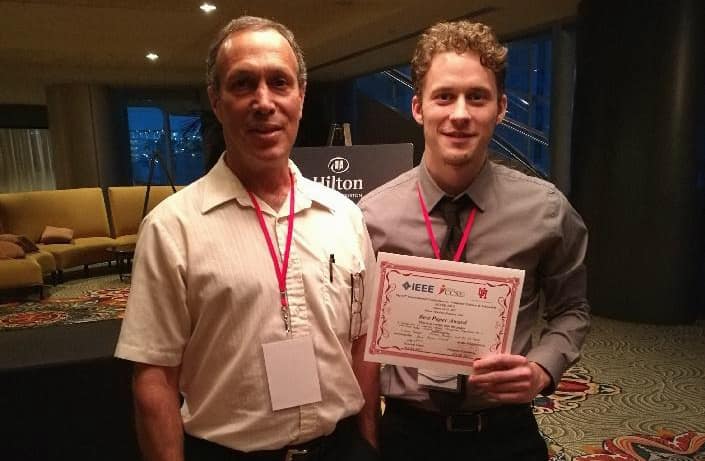Mobile Robotics Research Wins Best Paper Award at International Conference

Research related to navigation-control options for a low-cost indoor mobile robot recently received the Best Paper Award at the IEEE 12th International Conference on Computer Science and Education (ICCSE), Aug. 22-25, 2017, in Houston, Tex.
The paper, “A Comparison of Inertial-Based Navigation Algorithms for a Low-Cost Indoor Mobile Robot,” was written by Stephen Bruder, associate professor of computer and electrical engineering on Embry-Riddle’s Prescott, Ariz., campus; his former student Tobias Fauser, who is now pursuing a Ph.D. and a medical degree from Johns Hopkins University; and their collaborator, Aly El-Osery of New Mexico Tech.
The award-winning paper compared the accuracy of three different strategies for controlling the navigation of a QUANSER QBot 2 mobile robot, which looks like a roaming Roomba® vacuum cleaner robot but is useful for educational and research projects.
For navigation, Bruder explained, low-cost indoor robots can use encoders on their wheels that calculate a position based on the distance traveled from a starting point at a particular speed. Such robots can also make use of motion and rotation sensors called “inertial sensors.” (The Hubble telescope and Segway scooters use rotation sensors or “gyroscopes” to capture location information in three dimensions.) Depth cameras are yet another navigation strategy for small, low-cost robots. Just as a laser pointer that is repeatedly turned on and off will eventually generate enough data points to populate the pixels in an image, depth cameras produce “point clouds” to describe their surroundings.
Used individually, however, these navigation strategies are prone to errors. Bruder, Fauser and El-Osery completed experiments to show that a combination of technologies allowed a small, low-cost robot to more accurately fix its position. For example, combining inertial sensors, a depth camera and speed-controlling encoders “dramatically reduced the dead-reckoning drift to yield acceptable localization performance,” they reported in their paper.
The research team also developed and implemented their own unique navigation algorithm.
Now that Fauser has moved on to graduate school, Bruder is working with another undergraduate student, David Olsen, to expand upon the award-winning research and “get closer to something we can deploy.”

 Ginger Pinholster
Ginger Pinholster